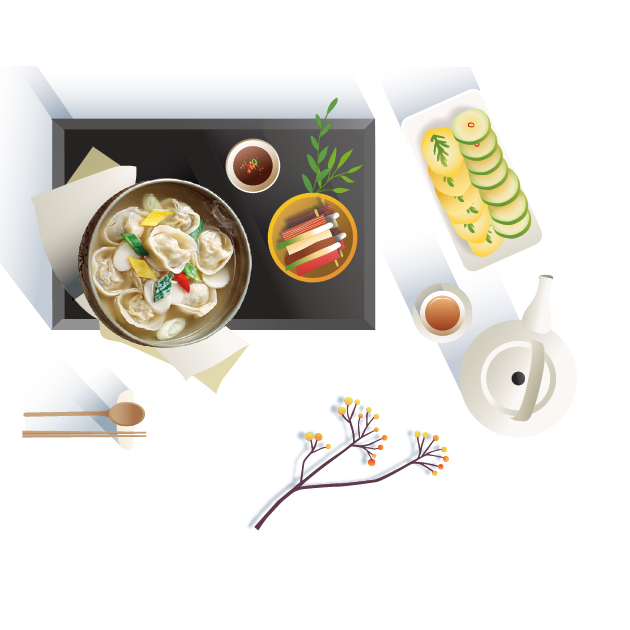한식 읽기 좋은 날
Vol 47. A New Day, Clean Color
Curious about Seolnal? Let’s Take a Look at Seol Food with Babdol
Korean Food Trivia Talk
Seol(New Year’s Day) is the first holiday of the year. Since it is the beginning of the year, all activities that involve eating and drinking on Seol are a ritual, and have a deep meaning.
Let's ruminate the meaning contained in the Seol customs and the Seol food culture that are naturally special.
Reference. Encyclopedia of Korean Seasonal Customs, Doopedia, the Ministry of Food and Drug Safet
Q. Is there a seasonal food eaten on New Year’s Eve, just like eating tteokguk on Seol?
A typical example is dumplings. New Year's Eve, meaning the last day of the past year, is called “Old Seol,” and, after dinner, the family performs the New Year’s bow to the elders of the family. The bow is also called “old bow,” and depending on the region, it is also performed before dinner. Just as it was believed that eating tteokguk on Seol would make you one year older, our ancestors thought that eating dumplings on this day would make you one year older. Also, on the same day before dinner, they held the ancestral rites with mandutguk(dumpling soup), which was called, “mandu charye(dumpling rites),” “mandu chasa,” or “guk jesa(soup rites).” Mandu charye is a ceremony that involves thanking ancestors for taking good care of the family throughout the year, and, at sunset, dishes such as dumpling soup, dongchimi(radish water kimchi), samsilgwa(3 kinds of fruits), and po(thinly sliced and cooked fish or meat) were set and offered to ancestors.
In some households, bokmandu or bomandu was made by putting small dumplings in a single dumpling. It is put when the dumpling soup is boiled again to eat during dinner after the rites, and the person who had this in a bowl was predicted to take the New Year’s fortune.

Q. On holidays such as New Year or Chuseok, the ancestral rites are offered to ancestors, and it is written as “darye(禮: tea ceremony)”. Why is it called darye when there is no tea offered?
It seems that a simple ritual among the rites was called charye, meaning “the custom of serving cha(茶: tea).” What became the norm for the gwanhonsangje(the four ceremonial occasions of coming of age, wedding, funeral, and ancestral rites) was <Garye> by Zhu Xi, a Chinese Confucian scholar of the Song dynasty. According to the book, on the first day of the new year and the winter solstice, and on the first day and full moon of each month, the rites should be held at the shrine where the ancestral tablets were enshrined. The rites are performed 31 times a year. In China, tea is consumed on a daily basis, but, in Korea, this is not the case, so it is written in <Sarye Pyeonram> that tea is not used in ancestral rites. Though tea is not served at ancestral rites, the simplest rites, such as those in China have been called charye(tea ceremony), and the one held on Seol is called “tteokguk charye.”
Q. Please tell us the meaning of Seju offered on the Seol charye table.
Since the ancient times, our people have had a custom of making seju(liquor used on Seol) in every house before the New Year, and drunk by the youngest family member on the morning of Seol. Yakju(rice liquor) and cheongju(refined rice liquor) were typically used, and most of them were yangjoju(brewed liquor), making it with the yeast made during the summer and white or sticky rice as ingredient. The liquor drank on the morning of Seol was called dosoju(spiced liquor), and people believed that drinking dosoju would dispel evil spirits, and make them live a long life. Dosoju is said to be made by Hua Tuo, a noted Chinese doctor from the late Eastern Han Dynasty, by adding bellflower root, Chinese pepper, wild parsnip, white atractylis, rosolio, and dried orange peel. Since the ancient times, seju was drank cold rather than heated. Our ancestors believed that spring was coming from the beginning of the year, and it is a custom created from the meaning of preparing to work in the beginning of spring.
Q. It is said that the calories of holiday food must be noted. Please tell us if there is a healthier way of eating Seol food.
Tteokguk is usually made by boiling beef bone broth. If you have heart disease or diabetes, you need to be very careful as the intake of saturated fat and cholesterol may increase from consuming beef bones. It is also a good idea to use oysters instead of beef bones. Oysters are rich in vitamins and minerals, and they are in season in the winter, so they are a good for health management because of their abundant nutrients. If you use a broth made with anchovies, shrimp, kelp, etc., you can enjoy a more refreshing taste. If you have high blood pressure, it is also a good idea to have less soup with tteokguk. It could become salty, as tteok is not seasoned so it might lead to excessive salt intake. Thus, it is recommended to consume less soup with a sour side dish.
It may be also helpful to reduce the amount of tteok in tteokguk. Compared to the amount of rice we usually eat, we consume so much carbohydrates, so it is recommended to increase the intake of vegetable side dishes to feel full. Eating plenty of vegetables increases fiber intake, and lowers postprandial blood sugar, as well as cholesterol and triglyceride levels.
Likewise, you can improve your health by increasing the amount of activity you do after eating Seol food by playing yutnori or jegichagi.
Q. How should I store Seol leftovers?
There are usually more food ingredients and leftover foods after the holiday, and they could be a headache. If meat is stored incorrectly, bacteria can grow easily, so divide the meat into single portions and coat it with olive oil evenly, and keep it frozen so you can eat it for a relatively long time. The defrosted meat should not exceed a day, while transferring the meat into the refrigerator the day before cooking and defrosting it slowly is a way of reducing nutrient destruction and loss of texture.
In the case of fish, remove the intestines, sprinkle with salt, pour in cooking wine, and refrigerate. Instead of cooking wine, you can use soju or cheongju with ginger or garlic. For seasoned vegetable dishes, storing them in a separate airtight container by type can slow the rate of spoilage. Stir-fried vegetables should be cooked again, cooled, and refrigerated. Jeon(pan-fried battered vegetables, meat or fish) dishes contain plenty of oil and can go rancid easily, so it is recommended to wrap them in paper foil, put them in an airtight container, and keep them in the freezer.
According to the Ministry of Food and Drug Safety, it is recommended to consume raw fish within three months, cooked fish within one month, and beef within 6 to 12 months.



 한국어
한국어
 English
English






